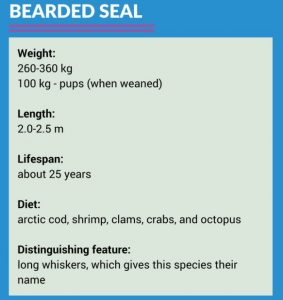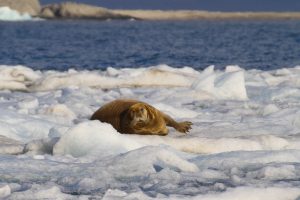Bearded seal
Bearded seal (Erignathus barbatus) is the largest species of seal living in the Arctic. It belongs to family of “true seals” (Phocidae). The animals prefer to relax on sea ice; observing them on land is rather unusual. Pups are born in the spring, usually in May.
They are able to enter the water only a few hours after they are born in order to avoid being eaten by polar bears. Pups consume about 8 litres of very fat milk (50% fat) per day. After a period of only 18-24 days of living with their mothers, they are ready to live on their own. During the breeding season, male bearded seals “sing” to attract females. Their “songs” in calm conditions might be heard up 19 km away.
Bearded seals’ fur might be grey or dark-grey with a light belly, although sometimes they have rust-coloured faces and fore flippers. Searching for food at the bottom of the sea (they usually dive to depths up to 200–300 meters) causes iron-compounds to from soft-bottom substrates, which stick to their hair, and chemically react with oxygen when the animal is out of water.
The main predator of the bearded seal is the polar bear.
Interesting facts
The Alaska population of bearded seals is regularly monitored by NOAA Fisheries.
- Bearded-seal (author: Dagmara Bożek-Andryszczak)
- Bearded seal (author: Piotr Andryszczak)




 This project (EDU-ARCTIC) has received funding from the European Union’s Horizon 2020 research and innovation programme under grant agreement No 710240. The content of the website is the sole responsibility of the Consortium and it does not represent the opinion of the European Commission, and the Commission is not responsible for any use that might be made of information contained.
This project (EDU-ARCTIC) has received funding from the European Union’s Horizon 2020 research and innovation programme under grant agreement No 710240. The content of the website is the sole responsibility of the Consortium and it does not represent the opinion of the European Commission, and the Commission is not responsible for any use that might be made of information contained.